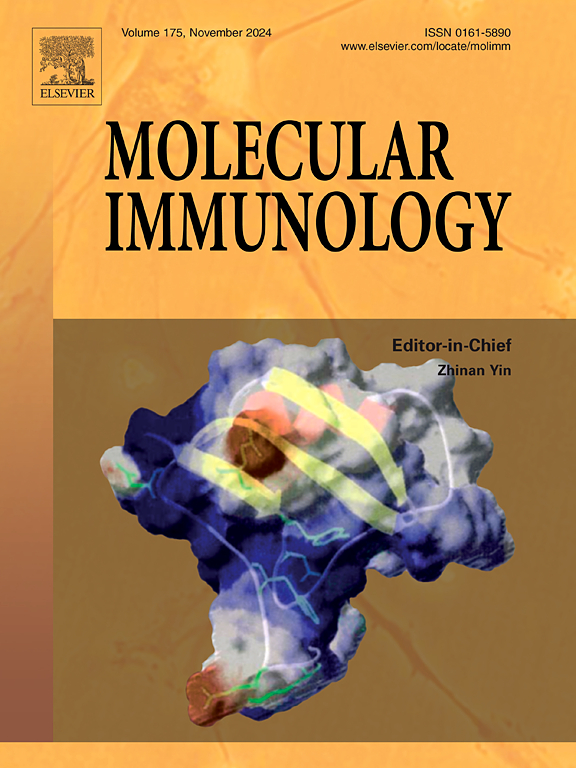LncRNA SNHG12通过调控TGF-β/Smad2/3信号通路促进结直肠癌EMT和转移
IF 3
3区 医学
Q2 BIOCHEMISTRY & MOLECULAR BIOLOGY
引用次数: 0
摘要
目的探讨SNHG12促进结直肠癌(CRC)进展的分子机制。方法利用生物信息学技术鉴定snhg12靶向mRNA及其与结直肠癌患者预后的相关性。建立了敲低SNHG12在HCT-116细胞系中的转染序列。采用CCK8法、结肠形成法、流式细胞术、细胞迁移法、transwell法检测SNHG12对HCT-116细胞的影响。采用qRT-PCR和western blot检测细胞凋亡和EMT标志物以及TGF-β和p-Smad2/3的表达。此外,通过过表达TGF-β的拯救实验和裸鼠皮下肿瘤模型,验证SNHG12在推动CRC进展中的关键作用。结果snhg12可以预测结直肠癌患者的预后,并从生物信息学角度获得靶基因GOLT1B。体外实验结果表明,SNHG12能促进HCT-116细胞的增殖、迁移和侵袭。qRT-PCR和western blot结果显示,SNHG12与Caspase 3、EMT标志物、TGF-β、p-Smad2/3的表达有关。同时,救援实验证明过表达的TGF-β能够逆转SNHG12敲除对细胞功能和表型的影响。在体内,SNHG12敲低可显著抑制肿瘤生长。结论snhg12通过调节TGF-β/Smad2/3信号通路和EMT过程促进结直肠癌的EMT和转移,可作为结直肠癌的预后生物标志物和治疗靶点。本文章由计算机程序翻译,如有差异,请以英文原文为准。
LncRNA SNHG12 promotes EMT and metastasis of colorectal cancer via regulating TGF-β/Smad2/3 signaling pathway
Objective
In this study, we aimed to explore the molecular mechanism of SNHG12 promoting colorectal cancer (CRC) progression.
Methods
Bioinformatics technology was utilized to identify SNHG12-targeted mRNA and the correlation with the prognosis of CRC patients. Transfected sequence of knockdown SNHG12 in HCT-116 cell line was established. CCK8 assay, colone formation assay, flow cytometry, cell migration and transwell assay were applied to detect the impact of SNHG12 on HCT-116 cells. Besides, qRT-PCR and western blot were employed to evaluate the apoptotic and EMT markers as well as the expression of TGF-β and p-Smad2/3. Additionally, the rescue test of overexpressing TGF-β and a nude mouse subcutaneous tumor model were established to validate the pivotal role of SNHG12 in driving the progression of CRC.
Results
SNHG12 could predict the prognosis of CRC patients, and a target mRNA GOLT1B was obtained from bioinformatics. In vitro results indicated that SNHG12 facilitated the proliferation, migration, and invasion of HCT-116 cells. qRT-PCR and western blot showed SNHG12 was related to the expression of Caspase 3, EMT markers as well as TGF-β and p-Smad2/3. Meanwhile, the rescue experiment proved that overexpressed TGF-β had the ability to reverse the impact of SNHG12 knockout on cell function and phenotype. In vivo, SNHG12 knockdown significantly reduced tumor growth.
Conclusion
SNHG12 promotes EMT and metastasis of CRC by modulating the TGF-β/Smad2/3 signaling pathway and EMT process, which could function as a prognostic biomarker and a treatment target for CRC.
求助全文
通过发布文献求助,成功后即可免费获取论文全文。
去求助
来源期刊

Molecular immunology
医学-免疫学
CiteScore
6.90
自引率
2.80%
发文量
324
审稿时长
50 days
期刊介绍:
Molecular Immunology publishes original articles, reviews and commentaries on all areas of immunology, with a particular focus on description of cellular, biochemical or genetic mechanisms underlying immunological phenomena. Studies on all model organisms, from invertebrates to humans, are suitable. Examples include, but are not restricted to:
Infection, autoimmunity, transplantation, immunodeficiencies, inflammation and tumor immunology
Mechanisms of induction, regulation and termination of innate and adaptive immunity
Intercellular communication, cooperation and regulation
Intracellular mechanisms of immunity (endocytosis, protein trafficking, pathogen recognition, antigen presentation, etc)
Mechanisms of action of the cells and molecules of the immune system
Structural analysis
Development of the immune system
Comparative immunology and evolution of the immune system
"Omics" studies and bioinformatics
Vaccines, biotechnology and therapeutic manipulation of the immune system (therapeutic antibodies, cytokines, cellular therapies, etc)
Technical developments.
 求助内容:
求助内容: 应助结果提醒方式:
应助结果提醒方式:


